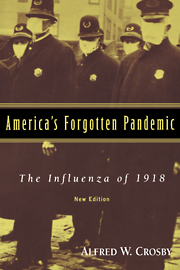Book contents
- Frontmatter
- Contents
- List of Graphs and Tables
- Preface to the New Edition
- PART I An Abrupt Introduction to Spanish Influenza
- PART II Spanish Influenza: The First Wave—Spring and Summer, 1918
- PART III The Second and Third Waves
- PART IV Measurements, Research, Conclusions, and Confusions
- PART V Afterword
- 15 An Inquiry into the Peculiarities of Human Memory
- Index
15 - An Inquiry into the Peculiarities of Human Memory
Published online by Cambridge University Press: 05 June 2012
- Frontmatter
- Contents
- List of Graphs and Tables
- Preface to the New Edition
- PART I An Abrupt Introduction to Spanish Influenza
- PART II Spanish Influenza: The First Wave—Spring and Summer, 1918
- PART III The Second and Third Waves
- PART IV Measurements, Research, Conclusions, and Confusions
- PART V Afterword
- 15 An Inquiry into the Peculiarities of Human Memory
- Index
Summary
Studying the record of the American people in 1918 and 1919 is like standing on a high hill and watching a fleet of many vessels sailing across a current of terrible power to which the sailors pay little attention. They grip their tillers firmly, peer at their compasses, and hold faithfully to courses, which, from their vantage, seem to be straight, but we can see that the secret current is sweeping them far downstream. The immense flow swamps many of the ships and their sailors drown, but the others take little notice. The others are intent on maintaining their own unwavering courses.
The important and almost incomprehensible fact about Spanish influenza is that it killed millions upon millions of people in a year or less. Nothing else—no infection, no war, no famine—has ever killed so many in as short a period. And yet it has never inspired awe, not in 1918 and not since, not among the citizens of any particular land and not among the citizens of the United States. This inaptitude for wonder and fear cannot be attributed to a lack of information. The destruction wrought by Spanish influenza is memorialized in reams of published statistics in every technologically advanced nation that was not in a state of chaos in 1918.
Single-handedly the flu thrust the year of 1918 back into the previous century. The United States Army lost a greater proportion of men to death by disease in 1918 than in any year since 1867.
- Type
- Chapter
- Information
- America's Forgotten PandemicThe Influenza of 1918, pp. 315 - 328Publisher: Cambridge University PressPrint publication year: 2003

